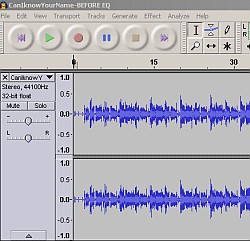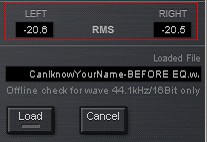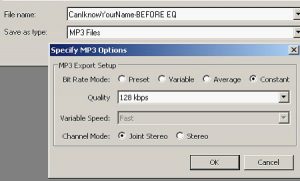This is the online version of AudioSpectro FIRE, a tool that can be used to assess the track frequency balance. This characteristic can be used to measure the quality of the audio tracks in WAV or MP3 version.
The overall quality is measured in terms of %frequency balance, a rating system that will compare your tracks to professionally produced/commercially released tracks in rock, pop and country genre that serves as the “reference”.
Before you can measure the quality of your audio material; raw data must be generated. This raw data is a text file (.txt) that will be uploaded to the online version of this tool (later on).
Install Required Software for Generating Data
a.) Audacity – download and install this open-source software. The recommended is the latest version 2.0.2 although 2.0.0. This is tested under Windows operating system.
b.) LAME MP3 encoder library– installed in Audacity. Follow the installation steps:
1.) Make sure Audacity is installed first in your computer.
2.) Go to this URL.
3.) Download the LAME MP3 encoder library depending on the operating system used. For example, for Windows operating system, click the link under “For FFMpeg/LAME on Windows” to download the installer. See the screenshot (enclosed in red box):
4.) After downloading, double-click the installer and proceed to installation. Use the default installation path provided by the installer.
5.) Launch Audacity, go to Edit — > Preferences — > Libraries.
6.) Click “Locate” and browse through the installed path (usually C:\Program Files\Lame For Audacity\lame_enc.dll) under “Program Files” in Windows; then select lame_enc.dll
Click OK.
7.) To check if you have successfully added the library, you should be able to find the MP3 library version such as the one shown below (inside the red box):
c.) TT Dynamic range meter– open this page in the browser and scroll down.
For Windows: download “TT-DR-Install.exe“.
For Mac: http://www.mediafire.com/?xzq2o9bpn84n5qz
After installation, you can view the program like this (e.g. in Windows XP — > Start –> All Programs)
d.) (OPTIONAL) Voxengo R8brain sample rate converter (if the source audio to be analyzed is not using 44100Hz as the sample rate).
Generate and Upload the Raw data
Generating raw data is very quick and easy. Please follow the instructions very carefully in this section to ensure data integrity. You can also refer to this YouTube video tutorial on generating raw data if there are unclear items on the steps:
1.) Launch Audacity, go to File — > Open. Locate the audio file in your computer. The following audio format is acceptable:
a.) 24-bit/44100Hz stereo audio WAV file (this is high quality/resolution format)
b.) 16-bit/44.1KHz WAV (also known as the audio CD format)
b.) Any MP3 format (preferably at least 128kbps 44.1 KHz sample rate)
Make a backup of your file in advance to prevent from accidental overwriting.
If you see a warning, just select “Make a copy of the files before editing (safer)” as the Import method. If the sample rate of your audio file is not 44.1 KHz (e.g. 48 KHz or 96 KHz); you should convert it to 44.1 KHz using Voxengo R8brain.
Example settings in R8brain for converting a 48 KHz mix down to 44.1 KHz, bit depth should be left unchanged:
Screenshot below after adding the file to Audacity:
2.) After loading the file in Audacity, go to File — > Export. In the “Save as type”, select “WAV (Microsoft) signed 16-bit PCM”.
Save the exported 16-bit WAV file to your Desktop with the same filename. This file will be used for adjusting the volume of your track to -20dB RMS.
3.) Launch TT Dynamic range meter offline mode. Go to Start — > All Programs — > Algorithmix — > TT-Dynamic-Range 1.1 — > TT DR Offline Meter 1.1
Click “Load” button and locate the exported 16-bit WAV file in your Desktop then click “Open” to load the file. TT Dynamic range meter automatically calculates the track loudness in dB RMS. See the screenshot (in red box):
There should be two values since the audio mix down file is in the stereo format.
4.) Calculate the needed volume adjustment by entering the RMS total loudness dB data for both LEFT and RIGHT channels in the calculator below. This is the needed adjustment to normalize the loudness of your track to -20dB RMS.
For example, inputting -20.6dB and -20.5dB as the RMS values (for LEFT and RIGHT) will provide a dB adjustment value of +3.47dB.
5.) Launch Audacity again and open your original source audio file (the file you open in Step1). Go to Effect — > Amplify. Enter the recommended dB adjustment (based on the above calculator) in the “Amplification (dB)”. For example (using the +3.47dB adjustment as illustrated previously). Don’t enter anything on “New Peak Amplitude (dB)“. Leave it as default.
Click OK to implement the setting.
6.) In Audacity. Go to File — > Export. In the “Save as type”, select “MP3 Files” then click “Options”. Set the following options:
Bit rate mode: “Constant”
Quality: “128kbps”
Channel Mode: “Joint Stereo”







